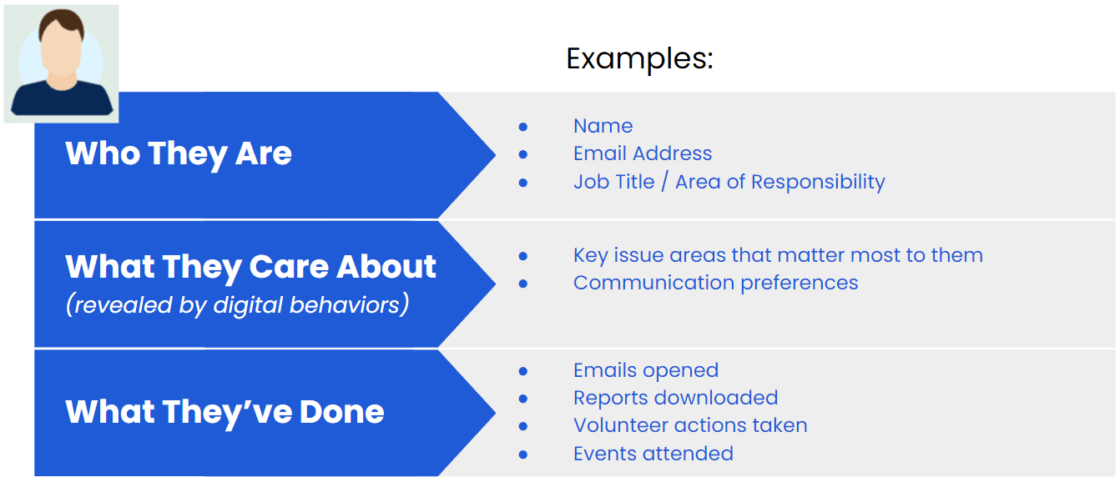Whether you’re communicating with members, donors or volunteers, your outreach will always be richer and more effective if you have a thorough understanding of the needs and interests of your supporters. Many teams attempt this by creating personas – fictional characters, developed through user research, who represent and humanize their most important audience segments.
As valuable as personas are for a communications strategy, they don’t necessarily help you steward deep conversations or implement campaigns if your team members can’t tailor their messaging to the preferences of the real-life supporters they’re engaging. If you want to segment and customize outreach, your organization needs to systematically capture key information on every person on your email list or CRM. In particular: Who are they? What issue areas do they care about most? And what’s their history of interactions with your nonprofit?
In short, for truly personalized outreach, what you need is a contact model.
Talk with us about your contact model
What is a contact model?
A contact model is a mental model of all the important info that a communications or fundraising professional would want to know about a supporter before they write an email, schedule a 1:1 meeting with them, or interact with them in any way. Of course, it includes basic info like their name, email, and donation history. Yet it also includes many other things that help your team engage with more precision and impact—for example, their job title and role; past events and webinars they’ve attended; the reports they’ve downloaded from your site; and who at your organization last spoke with them (and when).

Chances are that your organization has some elements of this model in some of its systems, but they are disconnected and inconsistent. For instance, your communications team has names and email addresses in their email system, while specific program areas maintain their own spreadsheets with names and areas of interest. Meanwhile, fundraising professionals likely track interactions and interests via a separate system.
In order for your organization to effectively scale engagement—boosting the efficiency and impact of all outreach, no matter who leads it—having these contact attributes clearly defined and consistently implemented is critical.
How do I determine which elements should be in our contact model?
Start by defining what a valuable, highly engaged audience member looks like to you. What’s their role? What are they doing for you (in order to advance your mission)? And what are they doing with you (as an advocate, using your services or materials)? For instance, a think tank might define a highly engaged audience member as:
A policy maker who is advocating for our policy and who comes to our events and downloads our policy primers.
If your organization has already developed user personas as part of its communications or content strategy work, these will be an excellent place to begin. If not, consider convening a cross-departmental group of staff to identify key audience segments, and the actions they want these groups of supporters to be taking as a result of your collective efforts.
With this knowledge in hand, it’s now time to brainstorm: What kinds of data on users’ interests, preferences, and work will help your fundraisers and communications experts more effectively target and tailor their messages to discrete audience segments?
How and where do we find the data for our contact model?
The next step is far more technical: determining where (if at all) this information is currently collected, maintained and utilized. This likely involves cataloguing the various systems, platforms, online tools, and informal spreadsheets that your internal departments and programs use to collect valuable data on your audience members.
Precisely because the info in a contact model tends to be scattered across silos in an organization—and thus take some effort to identify and centralize—it’s important at this stage to start winnowing down the number of attributes in your organization-wide model to a manageable number.
What can we do once we have a contact model?
With a clear contact model, and technical work to connect the dots between your various systems, your organization can establish a single system (or a few tightly coordinated systems) that serves as the “source of truth” for anyone in your organization tasked with outreach. This is where anyone will turn when they want to develop content strategy, segment fundraising messages, share new reports or event invites, or prepare for meetings with top donors. In our experience, the logical system for this is a CRM, and/or an advanced email system with robust contact modeling and tracking capabilities.
An explicit contact model can also unlock powerful new automation capabilities for your organization—for example, email messages that push interests from user fields into messages, and that add modular content based on these interests—that dramatically deepen audience engagement.
When’s the right time for our organization to develop a contact model?
As soon as a nonprofit has email addresses or audience members, it should develop a contact model! Anyone who wants to maximize the impact of their organization’s limited resources — or who wants to boost existing resources — will benefit from the boost in outreach effectiveness that a contact model makes possible.





